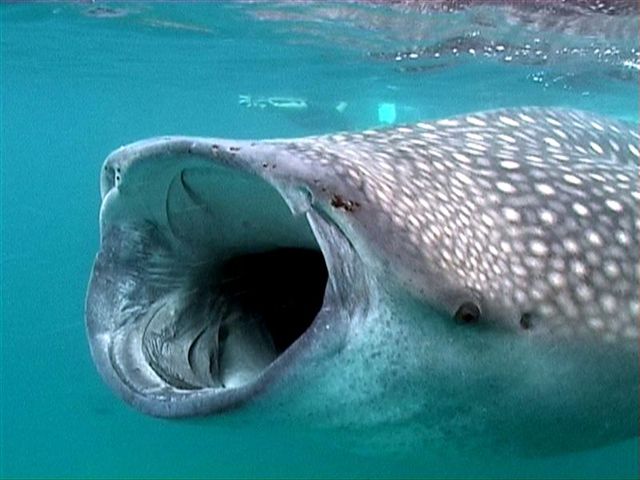
|
|
 |
||||||||||||||||||||
|
|
|||||||||||||||||||||
|
WHALE SHARKS Get Friendly with One of the Largest Filter-Feeders in the World By Jeannine Clark Orcas have been getting a bum rap lately, what with a trainer at SeaWorld being killed by one, and the BBC’s Planet Earth broadcasting footage of several of them ganging up on a helpless gray whale calf en route to its summertime home. So even if the possibility actually presented itself to swim with a killer whale, the decision to do so would likely be a foolhardy one. But there is an ocean-dwelling giant you can swim with if you’ve got a desire to do so. Described as having a  sofa-sized mouth, the gigantic whale shark (or Rhincodon typus) is a slow-moving, filter- feeding creature that swims near the ocean’s surface, consuming plankton and small fishes. The whale shark is the largest living fish species on the planet - and they are massive. (The largest accurately-measured whale shark was over 40-feet in length, with a 4 1⁄2 foot-wide mouth. Its dorsal fin stood 4 1⁄2 feet high, and its pectoral fins measured 6 1⁄2 feet long.) sofa-sized mouth, the gigantic whale shark (or Rhincodon typus) is a slow-moving, filter- feeding creature that swims near the ocean’s surface, consuming plankton and small fishes. The whale shark is the largest living fish species on the planet - and they are massive. (The largest accurately-measured whale shark was over 40-feet in length, with a 4 1⁄2 foot-wide mouth. Its dorsal fin stood 4 1⁄2 feet high, and its pectoral fins measured 6 1⁄2 feet long.)But despite their enormous size, whale sharks are remarkably gentle and curious, which makes swimming with them a unique treat for divers and snorkelers. Not afraid to come up close and check you out, even fishermen have been known to interact with them as they glide up alongside fishing boats, almost asking to be touched. In Belize, it’s possible to spot whale sharks between March and June. From June to August, the whale sharks travel near Holbox Island and Isla Mujeres, in Mexico’s Yucatan Peninsula. If you happen to be in the area, you can interact with whale sharks by taking a day tour - spending approximately five hours exploring the warm waters of the Mexican Caribbean. The Sea of Cortez near Bahia de Los Angeles in Baja California, Mexico is one of the spots where you can reliably see whale sharks in open waters. The closest destination to the U.S., you’ll find 4-to-6 day whale shark tours located there that use the popular eco-friendly Las Animas Wilderness Lodge as home base. The lodge is a boat-in only, multi-sport, all-inclusive destination located in the heart of the Midriff Islands. Private aircraft transports participants from nearby San Diego to the whale shark feeding grounds in just a few hours. The season in Baja runs from September 15th – October 27th, with 6-day tours costing around $2000. The Ningaloo Reef in Australia is the only reliable place you can swim with whale  sharks on that continent, and there are eco-tours offered at Exmouth. Further away, in the village of Donsol (in the Southeastern part of Luzon, in the Philippines), you’ll find eco-tours that allow you to swim with the butanding, the local name for whale shark. December through January is their best period for interaction. sharks on that continent, and there are eco-tours offered at Exmouth. Further away, in the village of Donsol (in the Southeastern part of Luzon, in the Philippines), you’ll find eco-tours that allow you to swim with the butanding, the local name for whale shark. December through January is their best period for interaction.However, if the Philippines, Australia, Belize or Mexico is a bit too far for you to get to, you can take a trip to the southern U.S. and visit the Georgia Aquarium’s Ocean Voyage exhibit, the only place in the world where you’re guaranteed to swim with a giant whale shark. The 2 1⁄2 hour experience costs $225 and includes all equipment, a souvenir t-shirt, photo and certificate of participation. And while the experience isn’t quite the same as swimming in the open ocean with one of the planet’s gentle giants, it sure beats the heck out of bar-hopping in Buckhead. FAST FACTS The following are some of the many sites containing information on organized swims with whale sharks: Australia: www.ningalooblue.com.au Baja, Mexico: www.bajaairventures.com Belize: www.ambergriscaye.com; www.belizespecialists.com Philippines: www.philippines.hvu.nl United States: www.georgiaaquarium.org Yucatan, Mexico: holboxisland.com; islawhalesharks.com Photos courtesy of Baja Airventures |
|
|
|
|
| Site Map |